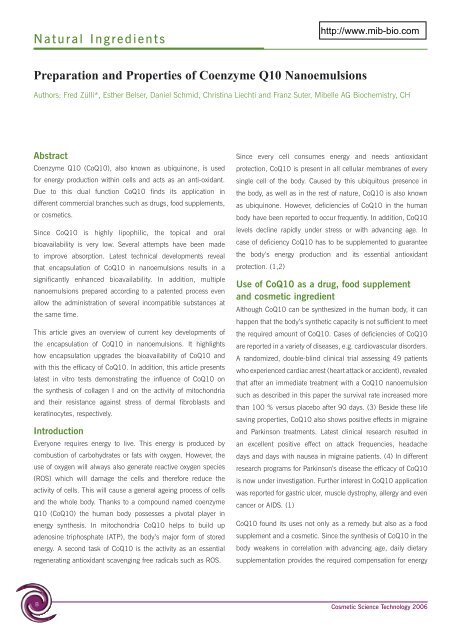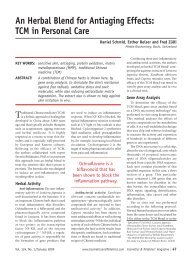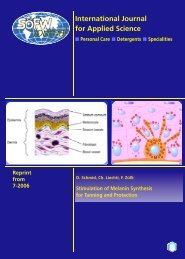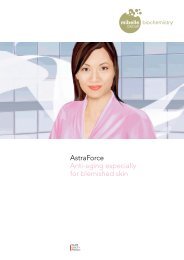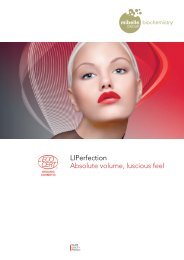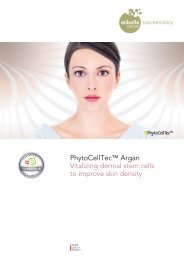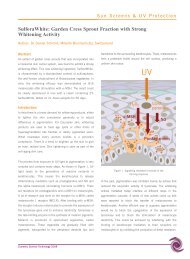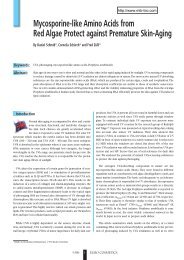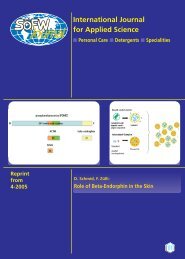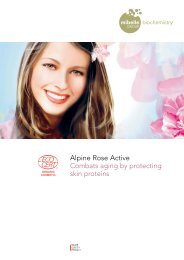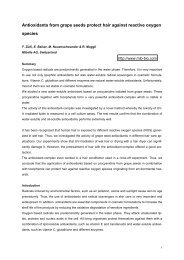Preparation and properties of coenzyme Q10 nanoemulsions
Preparation and properties of coenzyme Q10 nanoemulsions
Preparation and properties of coenzyme Q10 nanoemulsions
Create successful ePaper yourself
Turn your PDF publications into a flip-book with our unique Google optimized e-Paper software.
Natural Ingredients<strong>Preparation</strong> <strong>and</strong> Properties <strong>of</strong> Coenzyme <strong>Q10</strong> NanoemulsionsAuthors: Fred Zülli*, Esther Belser, Daniel Schmid, Christina Liechti <strong>and</strong> Franz Suter, Mibelle AG Biochemistry, CHAbstractCoenzyme <strong>Q10</strong> (Co<strong>Q10</strong>), also known as ubiquinone, is usedfor energy production within cells <strong>and</strong> acts as an anti-oxidant.Due to this dual function Co<strong>Q10</strong> finds its application indifferent commercial branches such as drugs, food supplements,or cosmetics.Since Co<strong>Q10</strong> is highly lipophilic, the topical <strong>and</strong> oralbioavailability is very low. Several attempts have been madeto improve absorption. Latest technical developments revealthat encapsulation <strong>of</strong> Co<strong>Q10</strong> in <strong>nanoemulsions</strong> results in asignificantly enhanced bioavailability. In addition, multiple<strong>nanoemulsions</strong> prepared according to a patented process evenallow the administration <strong>of</strong> several incompatible substances atthe same time.This article gives an overview <strong>of</strong> current key developments <strong>of</strong>the encapsulation <strong>of</strong> Co<strong>Q10</strong> in <strong>nanoemulsions</strong>. It highlightshow encapsulation upgrades the bioavailability <strong>of</strong> Co<strong>Q10</strong> <strong>and</strong>with this the efficacy <strong>of</strong> Co<strong>Q10</strong>. In addition, this article presentslatest in vitro tests demonstrating the influence <strong>of</strong> Co<strong>Q10</strong> onthe synthesis <strong>of</strong> collagen I <strong>and</strong> on the activity <strong>of</strong> mitochondria<strong>and</strong> their resistance against stress <strong>of</strong> dermal fibroblasts <strong>and</strong>keratinocytes, respectively.IntroductionEveryone requires energy to live. This energy is produced bycombustion <strong>of</strong> carbohydrates or fats with oxygen. However, theuse <strong>of</strong> oxygen will always also generate reactive oxygen species(ROS) which will damage the cells <strong>and</strong> therefore reduce theactivity <strong>of</strong> cells. This will cause a general ageing process <strong>of</strong> cells<strong>and</strong> the whole body. Thanks to a compound named <strong>coenzyme</strong><strong>Q10</strong> (Co<strong>Q10</strong>) the human body possesses a pivotal player inenergy synthesis. In mitochondria Co<strong>Q10</strong> helps to build upadenosine triphosphate (ATP), the body’s major form <strong>of</strong> storedenergy. A second task <strong>of</strong> Co<strong>Q10</strong> is the activity as an essentialregenerating antioxidant scavenging free radicals such as ROS.Since every cell consumes energy <strong>and</strong> needs antioxidantprotection, Co<strong>Q10</strong> is present in all cellular membranes <strong>of</strong> everysingle cell <strong>of</strong> the body. Caused by this ubiquitous presence inthe body, as well as in the rest <strong>of</strong> nature, Co<strong>Q10</strong> is also knownas ubiquinone. However, deficiencies <strong>of</strong> Co<strong>Q10</strong> in the humanbody have been reported to occur frequently. In addition, Co<strong>Q10</strong>levels decline rapidly under stress or with advancing age. Incase <strong>of</strong> deficiency Co<strong>Q10</strong> has to be supplemented to guaranteethe body’s energy production <strong>and</strong> its essential antioxidantprotection. (1,2)Use <strong>of</strong> Co<strong>Q10</strong> as a drug, food supplement<strong>and</strong> cosmetic ingredientAlthough Co<strong>Q10</strong> can be synthesized in the human body, it canhappen that the body’s synthetic capacity is not sufficient to meetthe required amount <strong>of</strong> Co<strong>Q10</strong>. Cases <strong>of</strong> deficiencies <strong>of</strong> Co<strong>Q10</strong>are reported in a variety <strong>of</strong> diseases, e.g. cardiovascular disorders.A r<strong>and</strong>omized, double-blind clinical trial assessing 49 patientswho experienced cardiac arrest (heart attack or accident), revealedthat after an immediate treatment with a Co<strong>Q10</strong> <strong>nanoemulsions</strong>uch as described in this paper the survival rate increased morethan 100 % versus placebo after 90 days. (3) Beside these lifesaving <strong>properties</strong>, Co<strong>Q10</strong> also shows positive effects in migraine<strong>and</strong> Parkinson treatments. Latest clinical research resulted inan excellent positive effect on attack frequencies, headachedays <strong>and</strong> days with nausea in migraine patients. (4) In differentresearch programs for Parkinson’s disease the efficacy <strong>of</strong> Co<strong>Q10</strong>is now under investigation. Further interest in Co<strong>Q10</strong> applicationwas reported for gastric ulcer, muscle dystrophy, allergy <strong>and</strong> evencancer or AIDS. (1)Co<strong>Q10</strong> found its uses not only as a remedy but also as a foodsupplement <strong>and</strong> a cosmetic. Since the synthesis <strong>of</strong> Co<strong>Q10</strong> in thebody weakens in correlation with advancing age, daily dietarysupplementation provides the required compensation for energyBCosmetic Science Technology 2006
Natural Ingredients<strong>and</strong> health. Additionally, poor nutritional habits or mental <strong>and</strong>physical stress may render Co<strong>Q10</strong> supplementation advisableas well. (5) To give an example, the integrity <strong>of</strong> mitochondria isessential for the health <strong>of</strong> cells <strong>and</strong> organs. Mitochondrial DNArepeatedly undergoes mutations caused by oxidative stress. Incomparison to nuclear DNA having a SOS DNA repair system,the mitochondrial DNA has no effective repair system to fightsuch mutations. Therefore, all mutations will accumulate duringtime <strong>and</strong> reduce the vitality <strong>of</strong> the cell. Hence, Co<strong>Q10</strong> is anessential antioxidant for mitochondria to protect the integrity <strong>of</strong>its own DNA as good as possible. (6)As a cosmetic ingredient Co<strong>Q10</strong> mainly acts as an antioxidantto protect the cells against the ageing process induced by freeradicals. Oxidative stress caused by free radicals or UV-irradiationplays a significant role in skin ageing. UV radiation is knownto induce the formation <strong>of</strong> reactive oxygen species which areimplicated as toxic intermediates in the development <strong>of</strong> photoageing.(7) The antioxidant activity <strong>of</strong> Co<strong>Q10</strong> prevents untimelyskin ageing <strong>and</strong> photo-ageing by enhancing the resistance <strong>of</strong> theskin <strong>and</strong> scavenging radicals. (8,9) A German research groupfound that Co<strong>Q10</strong> also suppresses collagenase, an enzymewhich causes damage <strong>of</strong> the connective tissue <strong>of</strong> the skin. Thegroup additionally showed that Co<strong>Q10</strong> is effective against UVmediated oxidative stress. (10) Taken together, these findingsturn Co<strong>Q10</strong> into a unique cosmetic substance which protectsthe skin from early ageing, wrinkle formation <strong>and</strong> loss <strong>of</strong>cell activity.Chemistry <strong>and</strong> bioavailability <strong>of</strong> <strong>Q10</strong>, <strong>and</strong> theprinciple <strong>of</strong> <strong>nanoemulsions</strong>Co<strong>Q10</strong> belongs to the group <strong>of</strong> quinones. It is composed <strong>of</strong> ap-benzoquinone ring system <strong>and</strong> a polyisoprenoid side-chain.The length <strong>of</strong> the side-chain is responsible for the lipophilicity<strong>of</strong> the molecule. The side-chain in Co<strong>Q10</strong> consists <strong>of</strong> tenisoprene units. This makes the molecule highly lipophilic. (11)Therefore Co<strong>Q10</strong> can freely move within the cellular membranes.Unfortunately, the bioavailability <strong>of</strong> Co<strong>Q10</strong> is very low in theintestines after oral application. (12)Several attempts have been made in the last few years to improvethe intestinal absorption <strong>of</strong> Co<strong>Q10</strong>. Researchers either triedto modify the molecular structure or change the compositions<strong>of</strong> the Co<strong>Q10</strong> preparations to improve the bioavailability. As amatter <strong>of</strong> fact, the investigation <strong>of</strong> both structure modifications<strong>and</strong> delivery systems revealed that bioavailability <strong>of</strong> Co<strong>Q10</strong> afteroral application can be significantly enhanced choosing a properformulation. (13,14)Modern research now shows that Co<strong>Q10</strong> <strong>nanoemulsions</strong>strikingly improve the bioavailability <strong>of</strong> the substance after oralapplication. (15) Daily application <strong>of</strong> 300 mg <strong>of</strong> powderedCo<strong>Q10</strong> results only in a serum concentration <strong>of</strong> 1.8 µg/ml after16 months. Thanks to encapsulation into <strong>nanoemulsions</strong>, thesame daily dosage <strong>of</strong> Co<strong>Q10</strong> enhanced serum concentration upto 5.2 µg/ml after only 6 weeks. (16,17)These <strong>nanoemulsions</strong> improve dermal bioavailability as well.It is known that encapsulation <strong>of</strong> drugs in <strong>nanoemulsions</strong> <strong>and</strong>liposomes enhance the drugs' concentrations in the dermiscompared to conventional formulations. (18) Figure 1 showsthe penetration <strong>of</strong> nanoparticles (nanoemulsion droplets) intothe skin <strong>and</strong> the release <strong>of</strong> the encapsulated material (Co<strong>Q10</strong>)(Figure 1).Features <strong>of</strong> <strong>nanoemulsions</strong>Figure 1:Schematic illustration <strong>of</strong> the penetration <strong>of</strong> nanoemulsion droplets into thestratum corneum <strong>of</strong> the skin. After the release <strong>of</strong> the encapsulated material thesubstances can penetrate into deeper layers <strong>of</strong> the skin.Cosmetic Science Technology 2006C
Natural IngredientsFigure 2:Structure <strong>of</strong> a nanoemulsion droplet. Phospholipids are arranged accordingtheir lipophilicity in the border area <strong>of</strong> the liquid oil dropletNanoemulsions (also named nanoparticles) are oil-in-wateremulsions having a small droplet size (30 – 300 nm). Figure 2illustrates the structure <strong>of</strong> a nanoemulsion droplet (figure 2).Phospholipids build the border area <strong>of</strong> the droplet <strong>and</strong> separatethe oily phase from the aqueous phase. Figure 3 shows anelectron microscope picture <strong>of</strong> a nanoemulsion containing Co<strong>Q10</strong>(figure 3). The oil droplets containing Co<strong>Q10</strong> are dispersed in thewater phase <strong>and</strong> have a diameter <strong>of</strong> about 50 nm. The small size<strong>of</strong> the droplets is achieved through high pressure homogenization.(19) A notable advantage <strong>of</strong> a nanoemulsion is its outst<strong>and</strong>ingstability, even at high temperatures up to 120 ºC.Figure 4:Nanoemulsions containing Co<strong>Q10</strong>. 1: 7% Co<strong>Q10</strong>, 2: 0.7% Co<strong>Q10</strong>, 3: 0.07%Co<strong>Q10</strong>. The droplet size <strong>of</strong> all preparations is around 50 nm.Figure 3:Particle size <strong>of</strong> <strong>Q10</strong> nanoparticles (around 50 nm) visualized by a TEM(transmission electron microscope).Of special interest is also the preparation <strong>of</strong> transparent Co<strong>Q10</strong><strong>nanoemulsions</strong>. These preparations can be obtained if a dropletsize <strong>of</strong> less than 60 nm can be achieved. This small droplet sizewill no longer scatter the light. However, Co<strong>Q10</strong> will still absorblight <strong>and</strong> therefore this preparation looks orange (figure 4).Figure 5:Correlation between particle size <strong>and</strong> transparency. 1: 54 nm, 2: 79 nm,3: 90 nm, 4: 102 nm, 5: 116 nm, 6: 197 nm.Nanoemulsions containing droplets above 100 nm look whitewhere as dispersions around 70 – 100 nm appear opaque <strong>and</strong>below that become transparent (figure 5).DCosmetic Science Technology 2006
Natural IngredientsNovel Co<strong>Q10</strong> <strong>nanoemulsions</strong>In this article we will present a novel Co<strong>Q10</strong> double nanoemulsionwith special <strong>properties</strong> manufactured according to a patentedprocedure. (20) The preparation consists <strong>of</strong> two different<strong>nanoemulsions</strong>. These individual <strong>nanoemulsions</strong> can nowcontain lipophilic compounds which are not compatible witheach other such as vitamin E <strong>and</strong> Coenzyme <strong>Q10</strong> (figure 6)which will form a dark complex when mixed together.Figure 6:Illustration <strong>of</strong> a multiple nanoemulsion containing two different inner phases.The substances <strong>of</strong> the two inner phases are not compatible with each other.Co<strong>Q10</strong> is obtained in its oxidized form <strong>and</strong> must therefore bereduced in the cell to act as an antioxidant. To facilitate thisreaction the reducing capacity <strong>of</strong> the cell has to be enhanced byadding vitamin E (natural tocopherol). The double nanoemulsioncontaining Co<strong>Q10</strong> <strong>and</strong> tocopherol in individual droplets istherefore a very smart solution to activate the cell vitality in anefficient manner. Since both individual <strong>nanoemulsions</strong> are basedon a droplet size <strong>of</strong> around 50 nm the mixed preparation istransparent <strong>and</strong> has a high bioavailability.The preparation <strong>of</strong> nanosize oil droplets <strong>of</strong>fers another featureto overcome a limitation <strong>of</strong> Co<strong>Q10</strong>. The solubility <strong>of</strong> Co<strong>Q10</strong> inoil is quite low. However, the solubility is enhanced at elevatedtemperature. We therefore prepared saturated Co<strong>Q10</strong> solutions at60 ºC <strong>and</strong> used these solutions to manufacture <strong>nanoemulsions</strong>at the same temperature. Due to the small droplet size thesesaturated Co<strong>Q10</strong> oil solutions remained solutions even afterthe temperature has been reduced to room temperature.These supersaturated Co<strong>Q10</strong> <strong>nanoemulsions</strong> can be stored atrefrigerated temperatures for many months without crystallization<strong>of</strong> Co<strong>Q10</strong> <strong>and</strong> are therefore very interesting products for theapplication in cosmetics, food supplements <strong>and</strong> cell culturesystems.The use <strong>of</strong> <strong>nanoemulsions</strong> in cell culture systems <strong>of</strong>fers newopportunities. Due to the small size these nanodroplets are easilyabsorbed by cells by means <strong>of</strong> endocytosis. This technique isdescribed in the US patent US 6,265,180 B1 <strong>and</strong> can be appliedas a novel nutritional delivery system in cell cultures. Severalstudies revealed that <strong>nanoemulsions</strong> containing Co<strong>Q10</strong> in cellcultures reduce the need for blood serum, enhance the growthrate <strong>of</strong> the cells, <strong>and</strong> increase the production <strong>of</strong> antibodies. Inone study the production <strong>of</strong> antibodies in hybridoma cells wasenhanced by 42%. (21)Use <strong>of</strong> Co<strong>Q10</strong> <strong>nanoemulsions</strong> in cosmeticsCo<strong>Q10</strong> encapsulated in the described <strong>nanoemulsions</strong> increasesthe synthesis <strong>of</strong> collagen I in fibroblasts. This effect was recentlyshown using normal human dermal fibroblasts (NHDF) <strong>and</strong> aCo<strong>Q10</strong> nanoemulsion at a concentration <strong>of</strong> 0.1%. Cells firstwere cultured at st<strong>and</strong>ard conditions without Co<strong>Q10</strong> during24 hours. Then the Co<strong>Q10</strong> nanoemulsion was added <strong>and</strong> cellswere incubated for 72 hours.The effect <strong>of</strong> Co<strong>Q10</strong> was evaluated by visualization <strong>of</strong> theprotein using a polyclonal antibody anti-collagen I <strong>and</strong> afluorescent second antibody anti-immunglobuline-FITC.Results were photographed applying microscopy observation.The photographs show an increased secretion <strong>of</strong> collagen Icompared to the control. (figure 7)This result demonstrates that Co<strong>Q10</strong> encapsulated in nanodropletspositively influences the expression <strong>of</strong> collagen I by fibroblasts.In a second in vitro assay the influence <strong>of</strong> Co<strong>Q10</strong> on the activity<strong>of</strong> mitochondrial dehydrogenase in keratinocytes was assessed.Cells (human adult low calcium high temperature cells, HaCaT)were cultured according to st<strong>and</strong>ard procedures <strong>and</strong> incubatedfor 72 hours with 0.1% <strong>of</strong> a Co<strong>Q10</strong> nanoemulsion. In a furtherstep cells were incubated with sodium dodecylsulfate (SDS,2µg/ml) for 24 hours to stress the cells.The mitochondrial dehydrogenase activity was analyzed usingthe MTT test. The application <strong>of</strong> the Co<strong>Q10</strong> nanoemulsionenhanced the activity <strong>of</strong> the unstressed keratinocytes to 116.8%+/-3.2% compared to the control 100.0% +/-1.3%. The SDStreatment decreased the cell activity to 67.1% +/-4.1%.Cosmetic Science Technology 2006E
Natural IngredientsFigure 7:Comparison <strong>of</strong> collagen I secretion by fibroblasts after incubation with Co<strong>Q10</strong> (left) <strong>and</strong> control (right).Pre-treatment with encapsulated Co<strong>Q10</strong> downsized thedamageing effect <strong>of</strong> SDS <strong>and</strong> the cell activity analyzed by theMTT test only decreased to 80.2% +/-1.6%. (figure 8)The assessment reveals that Co<strong>Q10</strong> <strong>nanoemulsions</strong> enhance themitochondrial activity <strong>of</strong> keratinocytes <strong>and</strong> protect them againstnecrotic stress factors.Dehydrogenase activity %140120100806040200SummaryCo<strong>Q10</strong> proved to be a unique substance providing differentpossibilities <strong>of</strong> application. In medicine, Co<strong>Q10</strong> is used forprevention <strong>and</strong> therapy <strong>of</strong> a variety <strong>of</strong> diseases. In nutrition,Co<strong>Q10</strong> finds its advantages as a food supplement. And, as acosmetic, Co<strong>Q10</strong> becomes an indispensable ingredient as anantioxidant <strong>and</strong> protective agent preventing skin ageing <strong>and</strong>photo-ageing.p
Natural Ingredients2004;110:3011-30164. S<strong>and</strong>or PS et al.Efficacy <strong>of</strong> <strong>coenzyme</strong> <strong>Q10</strong> in migraine prophylaxis: a r<strong>and</strong>omizedcontrolled trial.Neurology. 2005 Feb 22;64(4):713-5.5. Hojerova J et al.Coenzyme <strong>Q10</strong>--its importance, <strong>properties</strong> <strong>and</strong> use innutrition <strong>and</strong> cosmeticsCeska Slov Farm. 2000 May;49(3):119-23.6. Wei YH et al.Oxidative stress, mitochondrial DNA mutation, <strong>and</strong> impairment<strong>of</strong> antioxidant enzymes in ageing.Exp Biol Med (Maywood). 2002 Oct;227(9):671-82.7. Ibbotson SH et al.The effects <strong>of</strong> radicals compared with UVB as initiatingspecies for the induction <strong>of</strong> chronic cutaneous photodamage.J Invest Dermatol. 1999 Jun;112(6):933-8.8. Blatt T et al.Modulation <strong>of</strong> oxidative stresses in human ageing skinZ Gerontol Geriatr. 1999 Apr;32(2):83-8.9. Emerit IFree radicals <strong>and</strong> ageing <strong>of</strong> the skin.EXS. 1992;62:328-41.10. Hoppe U et al.Coenzyme <strong>Q10</strong>, a cutaneous antioxidant <strong>and</strong> energizer.Bi<strong>of</strong>actors. 1999;9(2-4):371-8.11. Boicelli CA et al.Ubiquinones: stereochemistry <strong>and</strong> biological implications.Membr Biochem. 1981;4(2):105-18.12. Wils P et al.High lipophilicity decreases drug transport across intestinalepithelial cells.Pharmacol Exp Ther. 1994 May;269(2):654-8.13. Kurowska EM et al.Relative bioavailability <strong>and</strong> antioxidant potential <strong>of</strong> two<strong>coenzyme</strong> q10 preparations.Ann Nutr Metab. 2003;47(1):16-21.14. Kommuru TR et al.Self-emulsifying drug delivery systems (SEDDS) <strong>of</strong> <strong>coenzyme</strong><strong>Q10</strong>: formulation development <strong>and</strong> bioavailabilityassessment.Int J Pharm. 2001 Jan 16;212(2):233-46.15. P<strong>and</strong>ey R et al.Nano-encapsulation <strong>of</strong> azole antifungals: Potential applicationsto improve oral drug delivery.Int J Pharm. 2005 Sep 14;301(1-2):268-76.16. Shults CW et al.Effects <strong>of</strong> <strong>coenzyme</strong> <strong>Q10</strong> in early Parkinson disease: evidence<strong>of</strong> slowing <strong>of</strong> the functional decline.Arch Neurol. 2002;59:1541-155017. Kohlert F et al.Bioavailability <strong>of</strong> <strong>Q10</strong> as powder vs <strong>Q10</strong> in nanoparticlesPublication in preparation18. Mezel MBiodisposition <strong>of</strong> liposome-encapsulated active ingredientsapplied on the skinin O. Braun-Falco, H. C. Korting, <strong>and</strong> H. I. Maibach, eds,Griesbach Conference on Liposome Dermatics; Heidelberg:Springer Verlag, Berlin, 206-14 (1992)19. Zuelli F et al.<strong>Preparation</strong> <strong>and</strong> <strong>properties</strong> <strong>of</strong> small nanoparticles for skin<strong>and</strong> hair careSOFW 1997;123(13):880-520. Zuelli F et al.<strong>Preparation</strong> consisting <strong>of</strong> at least two <strong>nanoemulsions</strong>Mibelle AG, EP 1 516 662 A1, Patentblatt 2005/1221. Zuelli F et al.Nanoemulsions for delivering lipophilic substancesinto cellsMibelle AG, US 6 265 180 B1, Jul. 24, 2001Primary Authors BiographyDr. Zülli obtained Ph.D. in Biochemistry from the Swiss FederalInstitute <strong>of</strong> Technology Zürich. His studies focused on structurefunction analysis <strong>of</strong> enzymes using methods based on molecularbiology. He worked in a postdoctoral position at the NestléResearch Center in the development <strong>of</strong> efficient expressionsystems <strong>of</strong> recombinant DNA in yeast.He is presently Head <strong>of</strong> Mibelle AG Biochemistry, a businessunit <strong>of</strong> Mibelle AG Cosmetics, the largest producer <strong>of</strong> cosmeticproducts in Switzerl<strong>and</strong>. In this position he is responsible forthe development, production <strong>and</strong> sale <strong>of</strong> active ingredients forskin care.Cosmetic Science Technology 2006G


